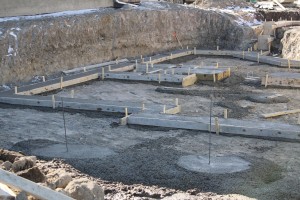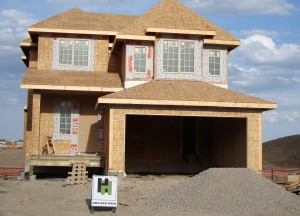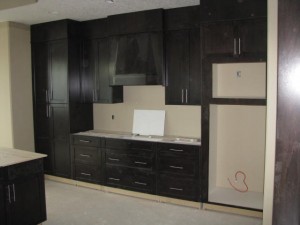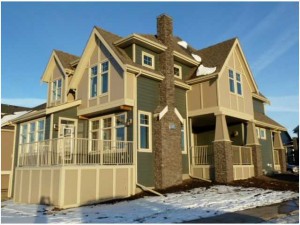Phase One: Pre-construction
Before any construction begins, you will work closely with the Architects to develop and finalize the home of your dreams. Once plans for your home are completed, they will be submitted to the developer for architectural review and then to the municipal building permit office for review. Permits may be required for all or some of the following work: building, electrical, plumbing, septic system and sewer connection. Once permits are received, construction on the home can begin. Prior to this, a number of site tests may be conducted to examine the water table, the soil and the bearing capacity of the ground and to conduct environmental tests. With this information, final engineering adjustments can be made to the plans.
Phase Two: Foundation
 Your house is staked out and the land is prepared. Often, the topsoil is removed and piled elsewhere for later use. Excavation is done, and the footings (concrete slabs to support the foundation walls) are formed and poured. Water, electricity, telephone and cable services may be brought in at this time. The foundation walls are erected (may use poured concrete in temporary wooden forms or permanent insulated blocks, concrete blocks or reserved wood, for instance). The foundation may be insulated and damp-proofed. Weeping tiles are installed to drain ground moisture away from the house. At this time, you will be asked to begin making your selections — deciding on appliances, flooring, cabinetry and so on. While it will be weeks/months before these items are installed, they must be ordered early to prevent delays later. A municipal inspection of the foundation may be conducted before the outside perimeter is backfilled.
Your house is staked out and the land is prepared. Often, the topsoil is removed and piled elsewhere for later use. Excavation is done, and the footings (concrete slabs to support the foundation walls) are formed and poured. Water, electricity, telephone and cable services may be brought in at this time. The foundation walls are erected (may use poured concrete in temporary wooden forms or permanent insulated blocks, concrete blocks or reserved wood, for instance). The foundation may be insulated and damp-proofed. Weeping tiles are installed to drain ground moisture away from the house. At this time, you will be asked to begin making your selections — deciding on appliances, flooring, cabinetry and so on. While it will be weeks/months before these items are installed, they must be ordered early to prevent delays later. A municipal inspection of the foundation may be conducted before the outside perimeter is backfilled.
Phase Three: Framing

Exterior walls, interior partitions and the roof are assembled. This usually means erecting a framing skeleton and applying an exterior sheeting; or another framing technique may be used. Frames are built on the floor, one wall at a time and then lifted in place. Roof trusses are most often brought to the site ready for installation, and roofing is completed as quickly as possible to prevent accidental damage as work progresses on the lower parts of the home. Windows and doors are installed. Harder Homes aim’s to get to “lock-up” as quickly as possible to protect the structure from the elements. The basement floor is installed. Electrical and plumbing services are roughed in, and ducting for heating, cooling and ventilation is put in place. At this time, your municipality will probably require a structural inspection to ensure that the home is being built according to building code requirements. Electrical and plumbing inspections will likely be conducted as well.
Phase Four: Interior and exterior work
 For the next several weeks, a great deal of work will happen inside and out, much of it at the same time, or overlapping. Proper scheduling is key to smooth progress. The exterior walls and the roof are insulated, and a vapour barrier is applied.Heating and cooling systems are installed, including fireplaces. Walls and ceilings are painted, flooring is laid, and kitchen and bathroom cabinets are installed. Plumbing and electrical fixtures are put in, trim is applied, and interior doors are hung. Siding is applied on the outside, along with eavestroughing, and porches and decks are installed. Final lot grading is done, and the driveway and walkways are put in. During this period, Harder Homes will stay in regular contact with you, to update you on progress and to meet deadlines for selecting finishes and other decisions you may need to make. Several additional municipal inspections may occur—for instance, after completion of the interior to check stairs, handrails and other health and safety related items, and/or after final grading outside. Plumbing and electrical work will probably require final inspection.
For the next several weeks, a great deal of work will happen inside and out, much of it at the same time, or overlapping. Proper scheduling is key to smooth progress. The exterior walls and the roof are insulated, and a vapour barrier is applied.Heating and cooling systems are installed, including fireplaces. Walls and ceilings are painted, flooring is laid, and kitchen and bathroom cabinets are installed. Plumbing and electrical fixtures are put in, trim is applied, and interior doors are hung. Siding is applied on the outside, along with eavestroughing, and porches and decks are installed. Final lot grading is done, and the driveway and walkways are put in. During this period, Harder Homes will stay in regular contact with you, to update you on progress and to meet deadlines for selecting finishes and other decisions you may need to make. Several additional municipal inspections may occur—for instance, after completion of the interior to check stairs, handrails and other health and safety related items, and/or after final grading outside. Plumbing and electrical work will probably require final inspection.
Phase Five: From near-completion to hand-over
 At this point, your builder and crew are busy completing the final touches and cleaning up. You will be asked to do a walk-through of your home and any last-minute touch-ups will be done. On the date of possession, you will be handed the keys-the home is now yours!
At this point, your builder and crew are busy completing the final touches and cleaning up. You will be asked to do a walk-through of your home and any last-minute touch-ups will be done. On the date of possession, you will be handed the keys-the home is now yours!
Source : CHBA


